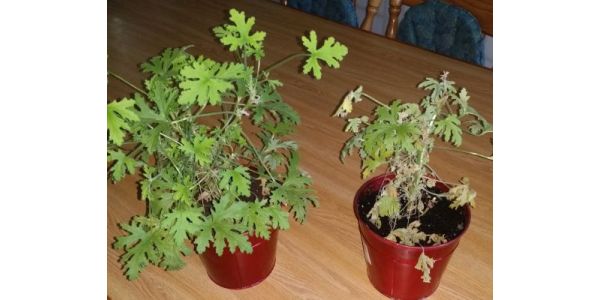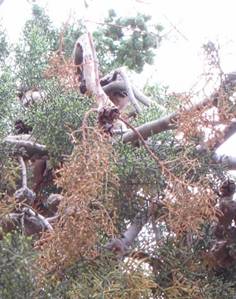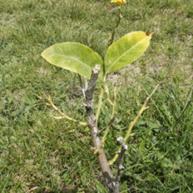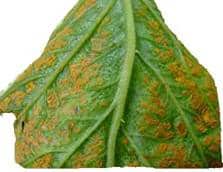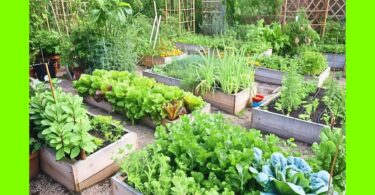Radko Tichavsky is a Czech born Mexican Agrohomeopath. He is a co-founder and director of Instituto Comenius in Mexico and author of Handbook of Agrohomeopathy, 2007 (Spanish) and Homeopathy for Plants, 2009 (Spanish) and creator and teacher of Holohomeopathy.
Agrohomeopathy Course!
Radko Tichavskyi is now offering a one semester virtual course in Agrohomeopathy (in English). You can learn how to define and analyze holons and how to repertorize the specific homeopathic treatment beyond just disease or pest names. You can find out more here: www.icomenius.edu.mx
A Materia Medica and Repertory for Plants: Mark Moodie hosts the website “Considera”, which provides a growing M.M and Repertory for plants and discusses resources for biodynamics and Agrohomeopathy .The website allows the world community to contribute their experiences in planting.
Dear Radko Tichavsky,
I just read about a new plant disease called Xylella fastidiosa, that originated in South America and is now leaping across the European continent. As well as crops, it threatens many forest trees, including oak, elm, ash, cherry, sycamore and plane. Could you suggest what we could do against it?
Here is a link to information about it:
Thank you
Jolanta Senele
Radko Tichavsky:
Dear Jolanta,
From my point of view there is no disease called Xylella fastidiosa, but a series of climatic changes (changes in the dynamis of the macroholon) that predispose different species of trees to this bacterium, that then show signs of maladaptation in the face of it. Then both bacteria and trees must undergo an adaptation process that is different in each species. The presence in Xylella f. in an oak, elm, ash, cherry, or sycamore, requires different homeopathic remedies, because in holohomeopathy we are healing not the illness but the patient: the holon. And in consequence of this treatment the pathogenic organisms disappear. Although for many people this seems to be a useless distinction, and they would expect to hear that a simple homeopathic remedy can solve the problem of Xylella fastidiosa in any crop, this is not possible. It is important to clarify, that if we address a disease as “caused by the bacteria” or if we consider that the bacteria is “caused and activated by the change in vital dynamism”, depending on the focus, or the understanding of the causes, it will or will not be a successful strategy of defense and healing and prevention. So the question “how should this problem be addressed?” is more than convenient.
To think that it is a South American, American or African disease, is to think from the anthropocentric perspective, that of course corresponds very little with the dynamics of a holon. Bacteria, like other microorganisms, do not live alone but form communities called syntaxons that can occur even when plants live in geographically distant conditions. That is, its presence in a crop is due to a symbiosis with other microorganisms (gram-negative bacteria for example which coexist frequently with phytoplasmas) under conditions of similarity. Diseases occur by similarity in conditions of disruption of the vital dynamis of the holon, and not necessarily by contagion.
Much of Western science bases its efforts on the sequencing of DNA and RNA by means of PCR and other methods, but due to pleomorphism, that is to say the possibility that a microorganism during its life exists in more than one form, the result is very relative. Pleomorphism was raised by Antoine Bechamp (former teacher and later opponent of Pasteur). Although pleomorphism was systematically denied, it is now known that pleomorphic bacteria and viruses exist, that is, they can exist in more than one form during their vital cycle, depending on the disposition of the vital dynamis of the holon and they are closely related with the Hahnemanian´s miasmas.
For example, a small increase in the temperature of the environment may lead to the emergence of new diseases, or may lead to relatively benign microorganisms becoming microorganisms of high virulence and epidemic hazards.
The solution is to understand how nature forms the syntaxons (dynamic communities of taxon collaboration) and how this approach to nature can bring light to current problems. The vital dynamis described by Hanneman has no temporality and no single location in a plant or in a single organism. Rather, it is formed, interconnected and established in a dynamic unity formed by parts (of the holon). However, the sum of the vital capacity of the parts are always exceeded by the vital capacity of the holon. The genius of Hahnemann consists not only in understanding that diseases are produced by similarity, and also by the same similarity they are cured, but that every remedy must be individualized, that is to say, there will not be a universal homeopathic remedy against Xylella fastidiosa. Only conscious repertorization of each holon will determine the remedy, based on the similarity between different living organisms.
Hello Mr Radko Tichavsky.
I am from Tunisia and hold a Master’s degree in research in cellular and molecular physiology of plants. Along with my studies, I studied management of Quality systems and Environmental systems at the National Institute for Standardization and Industrial Property.
I’m looking for a topic in Agrohomeopathy to use as a thesis for a degree program.
I wondered if you could suggest some area of research.
Since I use homeopathy with my children, I contacted the Society of Homeopathy in my country, but they didn’t know enough about Agrohomeopathy to help me.
Thank you
Asma Ben Boubaker
Radko Tichavsky:
Dear Asma,
You can download from our site www.comenius.edu.mx a free manual of agrohomeopathy in Spanish. Though it is very basic, it should give you some ideas to begin. You can also review some of my materials in the Hpathy.com website.
It is important to note that the knowledge of human homeopathy has very limited significance to plant homeopathy, and there is no direct relation of remedies used in humans and plants. In plants the remedy is related to each specie, for example, the remedy for aphids in Cucurbit sp. will be different from the remedy needed to treat the “same” aphid in apple trees, because the composition of secondary metabolites in each plant is different. Also, it’s different its relation to other parts of the holon. (mycota, microbios, plants lichens, insects, worms etc.)
In the past year I have presented a master’s degree thesis with the subject of agrohomeopathy at the University of Faro, Portugal. It was accepted and defended with success. There were also presented many master’s and doctorate theses in agrohomeopathy at the University of Vicosa, Brazil.
You would probably be the first person in your country to research and publish about agrohomeopathy, which is a great honor but also a big responsibility.
My best wishes for you
Dear Mr. Tichavsky,
I live in Western Australia. We have terrible issues with the Garden Weevil in our vineyard and are looking for a safe treatment where we don’t have to use any chemicals. Phlyctinus callosus is the name for the weevil. Any advice would be greatly appreciated.
Many thanks
Tyke Wheatley
Radko Tichavsky:
Dear Tyke,
Wine is one of the oldest crops in mankind and also one of the most used by man. It involved the management of grafts, varieties, and territorial distribution in places far from their holon of origin. Restoring certain conditions of the original wine holon helps to solve their health problems.
It is notable that the wild wine varieties, for example those that grow wild in the forest of northeastern Mexico where I live, present practically no pest or disease of importance as long as they can coexist with their forest friends, particularly Quercus spp. and the parasitic fungi like Ganoderma applanatum and some other fungi and yeasts that coexist specifically in the bark of the Quercus sp. If we observe the list of metabolic similarity of the wine, we find Ginkgo biloba, a single “fossil” tree between deciduous and pinaceous trees.
Ginkgo biloba (with 53 secondary metabolites with pesticides activity) and with 100 metabolites common with wine, and Juniperus communis (with 78 secondary metabolites with pesticide activity) and with 74 common metabolites with the wine, are the two plants with the highest degree of similarity to Vitis vinifera which are not affected by this pest. As far as are known, both Ginkgo biloba and Pinaceous trees are not affected by Phlyctinus callosus. That is, Quercus sp. with the associated fungus and the Juniperus sp., form together with the wine a syntaxon, a unit of collaboration and symbiosis among several species of living organisms that help each other to defend themselves and survive successfully in holon. The similar syntaxon is formed in connexion with Chinese origin Ginkgo biloba and Juniperus spp..
It is known that the survival of Phlyctinus callosus larvae in the soil is directly temperature dependent. A temperature of 15 degrees Celsius is ideal for the insect, while at a temperature above 30 degrees Celsius the larvae survival is only 1.7%. Survival also depends on the secondary metabolites of Juniperus spp. in some holons and Ginkgo biloba in others, and also of some fungus from Quercus spp. bark which compensate for their metabolites in the absence of high temperatures that inactivate the Phlyctinus callosus pest.
The ancient treatises of the Arab winemakers described a curious practice of placing in the hole, before planting the wine, a handful of acorns of crushed Quercus sp, so that their plants grew strong and without pests or diseases. Here the practice mainly refers to the endogenous fungi that arise, inoculating in the root system of the grape, rather than the secondary metabolites of the Quercus that has little similarity to the grape (for example Quercus alba shares only 47 metabolites with the wine) .
In summary, the remedies for this specific symptomatology of Phlyctinus callosus are as follows: Quercus bark inoculum (of the Quercus species present in each holon) Ginkgo biloba 12 CH sprayed on soil and plants, alternating with Juniperus communis 12 CH ,with adjuvant dependent on temperature: at low temperatures vegetable oil and at hot temperatures gel of Aloe vera or sap of Opuntia ficus-indica.
Dear Sir
I live in the south of France. There is a 20 years old cypress on the terrace. It’s not a good place but he was already there when we bought the house . Since 3 years, the tips of his branches dry out, then new ones appear, new fruits appear, then the seeds fall and it starts again. This poor tree runs out. Last week a gardener told me that it is a fungal disease and sprayed Fungi Comp (from Narayana/ homeoplant) but it seems worse. Also, what can we do against Horse-chestnut leaf miner?
Thank you Sir for your answer
Myriam Dettori
Radko Tichavsky:
Dear Myriam,
The fungal problems are relatively common in Cypressus spp. due to several factors: ozone contamination at the soil level, drought climate with consecutive heavy rains and reaction to irrigation with chlorinated water. Usually when people see the condition of the tree, they suppose that it lacks water and they increase irrigation, but this deepens the problem of fungus Phytophthora sp. Acid rain due to contamination can also weaken the tree by diluting the waxes that are protecting the leaf surface, causing greater susceptibility to attack by fungus. Rosmarinus officinalis and Thymus officinalis are the homeopathic remedies indicated for the problem, Aquilea millenfolium and Apium graveolens can also be useful. The remedies are used in 6 CH potency. Once a month you can apply Magnesium phosphoricum 6 CH.
Dry branches must be cut and burned to avoid reinfection by fungal spores.
In relation to the Cameralia ohridella, its appearance has to do with climatic changes. We use first Tilandsia usneoides 6 CH and one week later we apply Boswellia sacra 6 CH, sprayed on the leaves of the trees. It is applied on the leaves of the trees approximately in March, if necessary, and the application of Boswellia s. 6 CH can be repeated once a month.
Dear Radko Tichavsky,
I have two house plants called Pelargonium’citrosum (Mosquito Plant). In one, the soil dries out every 3 to 4 days. I have another of the same plant which is very healthy that I need to water only once every 12 days. Both plants are in the same place in my house and both get the same amount of sun light.
Best Regards
Andrew Hofer
Radko Tichavsky:
Dear Andrew,
There are many things in nature that are missing an explanation. Daily I marvel at new things, surprising aspects and unsuspected connections in the different aspects of holon life.
Most likely, the second plant has a problem with pathogenic fungi while the first one is associated with another mycorrhizal fungus that lengthens the root system of the plant, eliminates competing pathogenic fungi and also gives to the plant a special resistance to drought. The solution to your problem is relatively simple: take a little of the soil of the pot with the good plant, dissolve in a little water, add a little sugar and leave for two days without doing anything. Then pour this inoculum of beneficial organisms from the first pot and add them as irrigation water in the pot with less successful plants to adapt them. You can also add one or two applications of Natrum muriaticum 30 CH.
One of the rules of working in the holon is always to extend the message from the most vitalized to the less vitalized part of the holon. One of the beginner’s mistakes is to focus more on the pathogens and description of pests and diseases, rather than trying to understand the symptomatology and dynamis of the whole holon.
Unintentionally, this case of two equal pots illustrates and helps to understand the enormous epigenetic plasticity of plants (living beings) that happens even in cloned plants and those placed in controlled environments. Samuel Hahnemann attempted to describe the phenomenon with the term of vital dynamis, a non-material (non-genetic) principle that brings life to life and connects, like an invisible wind to countless vital processes. Under this principle, if we ask whether the pathogen caused the disease (vital imbalance or imbalance of vital dynamis) or if it was the disease that caused the pathogen, Hahnemann’s answer (and mine is the same) is clear: the imbalance in vital dynamis causes pathogens and not the other way around.
Thus in this case, even in two equal pots with equal substratum, in similar light and water conditions and with two plants reproduced by cutting, different vital processes can be produced with different pathologies, even though the two plants are placed next to other.

